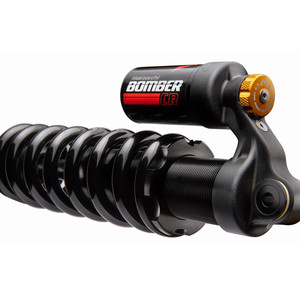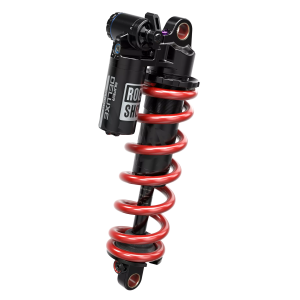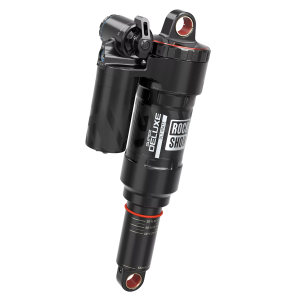SR Suntour TRIAir 3CR Rear Shock
| Where To Buy | |||
|---|---|---|---|
Free shipping on orders over $50 (continental U.S. only).
International shipping available. Some exclusions apply. |
|||
Free shipping on orders over $50 (continental U.S. only).
International shipping available. Some exclusions apply. |
|||

Suspension brand loyalty and setups, like most bits on a mountain bike, are highly subjective. A few years back, RockShox and FOX seemed to be the heavy hitters and appeared almost exclusively on most high-end mountain bikes. Recently, however, brands like DVO, Öhlins, Cane Creek, and EXT (to name a few) are gaining traction among both weekend warriors and elites. While SR Suntour may often be associated with entry-level and mid-range products, they have quietly been working their way into the high-end market and have aligned with big-name cross-country and DH teams, world-class freeriders, and EWS racers to help them push on with product development. SR Suntour actually produces close to 10,000,000 suspension products in a calendar year, and if the TriAir rear shock performs as advertised they might be producing a few more. The TriAir was designed to be a heavy-hitting unit capable of world class performance, in a simpler, more durable package.
Strengths | Weaknesses |
|
|
SR Suntour TriAir Highlights
- Intended Use: Trail, all-mountain and enduro riding
- Spring: Air, volume reducers can be used in both the positive and negative spring
- Damper unit: Internal floating piston with PCS cartridge
- IFP is adjustable between 180-240psi and affects initial stroke support
- External Compression: 3CR three position platform adjustment - Open, Medium, Firm
- Rebound: Ten clicks of adjustment
- Teflon bushings
- Trelleborg seals
- Standard, metric and trunnion mounting options
- Weight: 410 grams
- MSRP: $425 USD



Internal Floating Piston vs DVO’s Bladder
A little while back we had the opportunity to test the DVO Topaz, and we’ve decided that a comparison between the two is worthwhile as they have some similarities. While DVO chose to go the route of an adjustable bladder in the piggyback, SR Suntour chose to keep the TriAir shock a little more traditional with an internal floating piston (IFP). Much like the Topaz, the pressure it contains can also be adjusted using a shock pump. According to SR Suntour’s North American Marketing and Technical Service guru, JP Gendron, "Using an IFP results in much better long term consistency and reliability, as well as ease of service and manufacturing." Simplicity, durability, and ease of maintenance are all SR Suntour priorities, so it isn’t too much of a stretch to see why SR Suntour stuck with the more commonly utilized IFP for the TriAir.
Initial Impressions
For the purpose of this test we paired the metric-sized 205x65mm TriAir with the Norco Range 29. Our bike originally came equipped with the FOX Float X2 unit – arguably one of the most tunable and high performing rear shocks available, so the TriAir had big shoes to fill. Replacing the X2 with a seemingly less complicated product had us both excited and anxious. We have come to enjoy the flexibility that comes with the highly adjustable Float X2, however with the amount of time on the road and mileage that this bike sees we were keen to see if there was any loss of performance with a shock that we could maintain more easily while away from home.
Our initial tuning focus was the volume spacers, the 3CR compression adjustment, and rebound speed, with the understanding that IFP pressure could remain as an ace up our sleeve for micro adjustments down the line.
Our initial expectation when swapping to the TriAir was that we would need to utilize a fair number of volume spacers in both the positive and negative chambers to maintain our platform on the Range: a fairly supportive initial stroke with plenty of bottom-out resistance for the many g-outs found around Squamish. The ability to add and remove volume spacers while the shock remains in the frame makes this process straightforward. It only takes a few minutes to make volume spacer adjustments to the TriAir – something that would be even more beneficial at events where practice time is limited. We chose to begin with the recommended 30% sag, even though we had been riding around 24% with the Float X2. We also started with the IFP at the recommended 220psi. Our initial tuning focus was the volume spacers, the 3CR compression adjustment, and rebound speed, with the understanding that IFP pressure could remain as an ace up our sleeve for micro adjustments down the line.


The addition of volume spacers in either chamber modified shock behavior noticeably, which also meant that testing was a straightforward process.
Although the 3CR compression adjustment may appear to impose certain limitations, we found that the lack of external compression tuning options wasn’t a drawback. The negative and positive spring adjustability on the TriAir offers ample tuning options, and it felt quite linear compared to other air shocks without spacers, meaning that it might also be a great fit for more progressive suspension layouts. On the other end of the spectrum, when volume spacers were maxed out the TriAir felt more than progressive enough to deal with the largest of impacts. The addition of volume spacers in either chamber modified shock behavior noticeably, which also meant that testing was a straightforward process.
With no spacers in the negative spring, the shock is very sensitive off the top and provided tons of grip, but we found it wallowed when we were riding aggressively and even during technical climbs. For the Range 29, we found that a single negative spring spacer was ideal for daily driving in Squamish as a second spacer made things too harsh for our liking (editor’s note: we were riding flats at the time, and might have preferred a second spacer were we running clips). Our final settings on the negative side was a single spacer with the IFP pressure raised to 240psi which provided slightly more support than our original setting of 220psi. Our experience was that the IFP pressure could almost act as a half-step between spacers in the negative chamber. Positive spring adjustability was more straightforward with the TriAir, and three spacers ended up being our sweet spot. Once we had the spacers set to our liking, we found the best way to make small adjustments was to leave the number of spacers alone and use the IFP to make subtle changes to our suspension. When speeds were higher or for days in the bike park we maxed out the IFP at 240psi, and we plan on dropping the IFP pressure once the rains come and traction becomes the main priority.



On The Trail
While the TriAir may not receive as much fanfare as some of the other shocks on the market, we immediately noted how supple and smooth the shock felt off the top. SR Suntour’s Piston Compensator System – PCS for short – is a cartridge unit found within many of their high-end suspension units that is meant to improve the separation between air and oil, reduce cavitation, and ultimately improve performance. The TriAir performed very well in all situations and we had no surprises or oddities pop up during the test period. Not only does the PCS unit provide excellent performance, SR Suntour’s Quick Service Product philosophy means that more time can be spent on the trails and less in the stand, and the cartridge is capable of more than 200,000 damping cycles with very little maintenance.
While trail riding, the TriAir provided a ton of traction and the rear wheel stuck to the ground very well, but was progressive enough that we still had a lively ride.
With the settings mentioned above (1 negative spacer, 3 positive spacers, IFP at 240psi) and around 25% sag, we found that our test shock performed extremely well in most situations. While trail riding the TriAir provided a ton of traction and the rear wheel stuck to the ground very well, but was progressive enough that we still had a lively ride. The incremental external compression and rebound adjustments of the Float X2 that it replaced were missed when it came to riding trail one day and bike park the next, but the 3CR adjustment on the TriAir worked well with the Open setting being ideal for more technical and lower speed trails and the Medium 50% compression setting feeling better on smoother flow trails with rollers and jumps like in the bike park. The firmest 3CR setting utilizes 80% compression, so it doesn’t lock the suspension entirely. We found this most useful on smooth climbs. The compression adjustment lever is quite large, so it is easily accessible on the trail, but depending on your bottle, cage, and frame combination it could also get in the way.


We are still tinkering with our TriAir setup to achieve an optimal balance between supple and supportive, but we’ve been more than happy in most situations, including long descents in the Whistler Bike Park where some shocks struggle to maintain their performance or overheat on sustained descents. It remains to be seen how cold weather affects the TriAir’s performance.
Things That Could Be Improved
We got along well with the SR Suntour TriAir for the duration of the test, but we would have liked a little more freedom to adjust rebound as we found the shock performed best at the highest rebound speed and we would have liked to try a few more clicks. Also note that the large compression adjustment lever may interfere with some water bottle mounts in the firmest position, and that it can be difficult to feel the clicks of the rebound adjustment knob.

Long Term Durability
SR Suntour hasn’t been shy about promoting the durability and long service intervals of their products. The phrase “Quick Service Product” has been coined to highlight exactly this, and in our experience the TriAir lives up to the billing – it is easily serviceable and maintenance is hassle free. SR Suntour recommends nothing more than a little grease for the dust seals every 125 miles or so, and a full service through one of their North American offices or an approved partner annually. It is also worth noting that maintenance and service documents can be found on SR Suntour’s website for those who prefer to rebuild their own shock.
During three months of use, the TriAir was completely free of reliability hiccups. Once we had the tuning to our liking we rode without any issues or surprises. Shock hardware remained smooth, we experienced very little air loss, and the internals feel every bit as smooth as day one. Even after time in Whistler Bike Park, arguably the best place on Earth to destroy bikes, we’ve come away with nothing to give us any indication that the TriAir is susceptible to premature wear or other long term issues.

What's The Bottom Line?
“Refined simplicity” is one of SR Suntour’s primary marketing slogans. While countless tuning options and clicks may seem all the rage on new products, the TriAir goes in the opposite direction by doing the basics extremely well. We found the adjustability of the shock to be more than adequate to keep any tinkerer busy, but we feel that riders who tend to simply check air pressure and go will also really appreciate the TriAir. The ease of service and reliability of the TriAir ensured that little time was wasted on the stand, and excellent customer support from SR Suntour North America and Werx Service Center partners gives us confidence knowing that any issues will be sorted quickly. The SR Suntour TriAir shock is proof that world class performance doesn’t need to be too complicated.
Visit www.srsuntour-cycling.com for more details.
_______________________________________________________________________
About The Reviewer
Joel Harwood – Age: 35 // Years Riding: 20+ // Height: 5’11” (1.80m) // Weight: 185-pounds (83.9kg)
Joel’s unique coaching background and willingness to tinker with products bring an objective perspective to testing. He dabbles in all types of racing, but is happiest simply exploring the limitless trail networks surrounding his home of Squamish, BC. Attention to detail, time in the saddle, and an aggressive riding style make Joel a rider that demands the most from his products while exposing any shortcomings.
Photos by Zak Berrisford and Joel Harwood // Ridden by Jacob Murray
Specifications
Internal Floating Piston (IFP) system
Piggy back pressure adjust
Piston compensator system
3CR damper
8-Click rebound
| Where To Buy | |||
|---|---|---|---|
Free shipping on orders over $50 (continental U.S. only).
International shipping available. Some exclusions apply. |
|||
Free shipping on orders over $50 (continental U.S. only).
International shipping available. Some exclusions apply. |
|||

























3 comments
Post a reply to: Tested: SR Suntour TriAir Shock